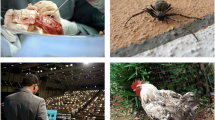Abstract
Our understand of gelotophobia remains incomplete, as samples seldom include large numbers of individuals with marked and extreme fear, due to their low prevalence. Consequently, little is known about how they differ from those at the lower end of the continuum of fear. With the aim of expanding on the study of Platt (2008), in the current study, participants covering the spectrum from no fear, slight, marked and extreme gelotophobia were randomly assigned to the Ridicule Teasing Scenarios questionnaire (RTSq; n = 295) or the Gelotophobia Checklist (GC; n = 143). When answering the RTSq, extreme gelotophobes, compared to marked gelotophobes, experienced more surprise and higher shame (but not higher fear) in response to ridicule. Furthermore, for these individuals the teasing scenarios elicited lower joy, higher surprise, shame and fear. The GC revealed that extreme gelotophobes have higher subjective intensity ratings of fear than marked but they did not differ in the number of physical symptoms experienced. Gelotophobes tend to experience muscle tension, sweating and blushing most frequently when encountering laughter. These findings will assist with developing programs for helping gelotophobes manage both their fear and the resulting symptoms.

Similar content being viewed by others
References
American Psychiatric Association. (2013). Diagnostic and statistical manual of mental disorders. Fifth (text ed.). Arlington, VA: American Psychiatric Publishing.
Barr-Zisowitz, C. (2000). “Sadness”- is there such a thing? In M. Lewis & J. M. Haviland-Jones (Eds.), Handbook of emotions (2nd ed., pp. 607–622). London, UK: Guilford.
Ekman, P. (2003). Emotions revealed: Recognizing faces and feelings to improve communication and emotional life. New York, NY: Times Books.
Fontaine, J. R. J. (2009). Shame. In D. Sander & K. R. Scherer (Eds.), The Oxford companion to emotion and the affective states (pp. 367–368). Oxford, UK: Oxford University Press.
Gosling, S. D., Vazire, S., Srivastava, S., & John, O. P. (2004). Should we trust web-based studies? A comparative analysis of six preconceptions about internet questionnaires. American Psychologist, 59, 93–104. https://doi.org/10.1037/0003-066X.59.2.93.
Janes, L. M., & Olson, J. M. (2000). Jeer pressure: The behavioral effects of observing ridicule of others. Personality and Social Psychology Bulletin, 26, 474–485.
Lader, M., & Marks, I. (1973). Clinical anxiety. London, UK: Heinemann.
Platt, T. (2008). Emotional responses to ridicule and teasing: Should gelotophobes react differently? Humor: International Journal of Humor Research, 21(2), 105–128. https://doi.org/10.1515/HUMOR.2008.005.
Platt, T., & Forabosco, G. (2012). Gelotophobia: The fear of being laughed at. In P. Gremigni (Ed.), Humor and health promotion (pp. 229–252). Hauppauge, NY: Nova Science Publishers.
Platt, T., & Ruch, W. (2007). Structured Gelotophobia interview. University of Zurich, Switzerland: Unpublished research tool.
Platt, T., Ruch, W., Hofmann, J., & Proyer, R. T. (2012). Extreme fear of being laughed at: Components of gelotophobia. The Israeli Journal of Humor Research: An International Journal, 1, 86–106.
Proyer, R. T., Ruch, W., Ali, N. S., Al-Olimat, H. S., Amemiya, T., Andualem, T., et al. (2009). Breaking ground in cross-cultural research on the fear of being laughed at (gelotophobia): A multi-national study involving 73 countries. Humor: International Journal of Humor Research, 22, 253–279. https://doi.org/10.1515/HUMR.2009.012.
Ruch, W. (2004). Gelotophobia: A useful new concept? IPSR spring 2004 colloquium series, department of psychology. University of California at Berkeley.
Ruch, W., Hofmann, J., Platt, T., & Proyer, R. T. (2014). The state-of-the-art in gelotophobia research: A review and some theoretical extensions. International Journal of Humor Research, 27, 23–45. https://doi.org/10.1515/humor-2013-0046.
Ruch, W., & Proyer, R. T. (2008a). The fear of being laughed at: Individual and group differences in Gelotophobia. Humor: International Journal of Humor Research, 21, 47–67. https://doi.org/10.1515/HUMOR.2008.002.
Ruch, W., & Proyer, R. T. (2008b). Who is gelotophobic? Assessment criteria for the fear of being laughed at. Swiss Journal of Psychology, 67, 19–27. https://doi.org/10.1024/1421-0185.67.1.19.
Ruch, W., & Proyer, R. T. (2009). Extending the study of gelotophobia: On gelotophilia and katagelasticism. Humor: International Journal of Humor Research, 22, 183–212. https://doi.org/10.1515/HUMR.2009.009.
Stein, N. L., & Levine, L. J. (1990). Making sense out of emotion: The representation and use of goal-structured knowledge. In N. L. Stein, B. Leventhal, & T. Trabasso (Eds.), Psychological and biological approaches to emotion (pp. 45–74). Hillsdale, NJ: Erlbaum.
Titze, M. (1996). The Pinocchio complex: Overcoming the fear of laughter. Humor and Health Journal, 5, 1–11.
Titze, M. (2009). Gelotophobia: The fear of being laughed at. Humor: International Journal of Humor Research, 21, 27–48. https://doi.org/10.1515/HUMR.2009.002.
Winfrey, C. (1993). Just teasing. American Health, 18, 66–68.
World Health Organization. (2004). ICD-10 classification of mental and behavioral disorders: Clinical descriptions and diagnostic guidelines (Second ed.). Geneva: World Health Organization.
Author information
Authors and Affiliations
Corresponding author
Ethics declarations
Ethical Approval
This study was conducted with full compliance to ethical standards being observed. Participation was with fully informed consent and with permission for the study granted by the University of Zurich Ethics Committee.
Additional information
Publisher’s Note
Springer Nature remains neutral with regard to jurisdictional claims in published maps and institutional affiliations.
Rights and permissions
About this article
Cite this article
Platt, T. Extreme gelotophobia: Affective and physical responses to ridicule and teasing. Curr Psychol 40, 6076–6084 (2021). https://doi.org/10.1007/s12144-019-00510-8
Published:
Issue Date:
DOI: https://doi.org/10.1007/s12144-019-00510-8



